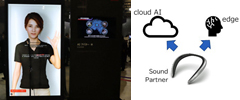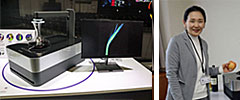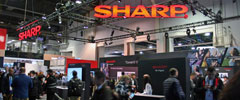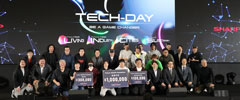Solar panels mass-produced at an LCD display factory?
– Introducing the high-efficiency, low-cost Indoor Photovoltaic Device LC-LH Contributing to achieving SDGs –
January 12, 2023

(LC-LH is on the far left, which doesn’t have a display)
Sharp has developed LC-LH indoor photovoltaic device. It has high power generation efficiency even under weak indoor light, and by utilizing the equipment and manufacturing know-how of existing LCD display factories, it is possible to mass produce at significantly lower costs and with higher quality. This device combines dye-sensitized solar cells*1 and liquid crystal display manufacturing technology, and is expected to be used to replace disposable batteries, contributing to the achievement of the international SDGs.
we received the Minister of Economy, Trade and Industry Award, one of the top awards of the CEATEC AWARD 2022 * 2 , at CEATEC 2022, Japan’s largest IoT exhibition held in October last year, which has been gaining acclaim and attention, and plans to begin mass production in FY2023 using an existing LCD display factory.
We also exhibited “LC-LH” at CES 2023, one of the world’s largest technology trade shows, held in Las Vegas, Nevada, USA from January 5th (Thursday) to January 8th (Sunday).
*1 A type of organic solar cell that converts light absorbed by pigments into electricity.
*2 ”CEATEC AWARD 2022 ” is a selection of technologies, products, services, etc. exhibited at “CEATEC 2022” that the “CEATEC AWARD 2022 Judging Committee” evaluates from academic and technological perspectives, marketability, future potential, etc. Based on these, we examine and select those that can be evaluated as highly innovative and excellent, and then award them.
This time, we interviewed the development staff of Corporate Research and Development (R&D) Group of Sharp and the planning staff of Sharp Display Technology Co., Ltd. (SDTC), responsible for manufacturing, planning, and sales to explain the features of the LC-LH. We asked them about the background of the development of this device, as well as their efforts to raise awareness of the device through CEATEC 2022.

― Firstly, tell us about the features of Indoor Photovoltaic Device LC-LH.
<Features of Indoor Photovoltaic Device LC-LH>
① Approximately double the power generation performance compared to conventional models*3 (in indoor light environment)
② Can be manufactured at low cost and high quality
③ Creating a convenient and comfortable product that does not require a power cord
④ Reduces the use of disposable batteries and contributes to achieving SDGs
*3 Comparison with amorphous silicon solar cells commonly used for indoor applications under illuminance of 500 lux (according to Sharp research)
→①: (Tsuda) This device uses dye-sensitized solar cells, which can generate power even with weak indoor light and with high power generation efficiency. For indoor power generation applications, amorphous silicon solar cells are used commonly in calculators and such, but the power generation efficiency of LC-LH, which uses dye-sensitized solar cells, is approximately double of that *3. It has the industry-leading power generation performance as indoor photovoltaic power generation.

→②:(Ichinose) LC-LH is not just a device that has changed its name from a dye-sensitized solar cell. What is noteworthy is that this device can be mass-produced by utilizing liquid crystal display (LCD) manufacturing technology and manufacturing flow. In the same way that a liquid crystal display seals the liquid crystal between two pieces of glass, LC-LH seals the dye and electrolyte between the two glasses, and uses a similar structure and manufacturing flow. Therefore, it can be mass-produced at a liquid crystal display factory, resulting in a high-quality device that is significantly lower cost than conventional dye-sensitized solar cells and utilizes the know-how of liquid crystal display manufacturing technology that has been accumulated over many years.

→③④:(Tsuda) Products equipped with LC-LH do not require a power cord. Since it generates its own power, it can be installed into IoT products such as electronic shelf labels, electronic POPs, and sensors related to healthcare and the environment, and it also helps reduce the amount of disposable batteries thrown away. Additionally, when installing a beacon *4 indoors such as in a room or hallway, multiple power sources are required, but since LC-LH does not require battery replacement, it can be installed in a variety of locations such as in high places or out of sight. These products contribute to a convenient and safe society while realizing the SDGs of recycling and clean energy.
*4 Radio wave transmitter. In environments where radio waves are difficult to reach, such as underground malls, it is used for purposes such as pinpointing locations by receiving radio waves transmitted by beacons as an alternative to GPS.


― Why was it decided to develop LC-LH?
(Ichinose) Many shelf labels that display prices at supermarkets are still paper, and when changing prices, it is necessary to manually replace each label one by one. On the other hand, electronic shelf labels that allow instant price changes are becoming more popular, but they generally use button batteries as a power source and require periodic battery replacement. For this reason, we thought that there would be a growing need for dye-sensitized solar cells that have high conversion efficiency even in weak indoor light and do not require battery replacement. However, in the beginning, they were manufactured in a small way using the specialized equipment within Corporate R&D Group of Sharp, and there were cost issues. Therefore, a discussion arose as to whether costs could be reduced by mass production using SDTC’s LCD display factory.
Solar cells are generally made of solid materials, such as crystalline silicon solar cells for residential use, but for indoor use, it is possible to use liquid type dye-sensitized solar cells. We came up with the idea that if we created a structure similar to LCD displays that also use liquid crystal, we could reuse existing LCD factories, and Corporate R&D Group of Sharp and SDTC decided to proceed with joint development.
― How did you proceed this development?
(Ichinose) The first thing that comes to mind as an area that requires cost improvement is the dye adsorption flow. Dye-sensitized solar cells use a dye that absorbs irradiated light and emits electrons, and in order to generate electricity, the dye must be adsorbed to the electrodes. Conventionally, dyes were adsorbed by a method called “immersion method,” in which the glass substrate of a solar cell with electrodes formed was soaked in a liquid containing dissolved dye.
In contrast, liquid crystal displays use a liquid crystal encapsulation technology called ODF *5 , which allows liquid crystal to be distributed throughout the display simply by dropping it. This caught my attention and I wondered if it would be possible to adsorb dye using a similar process. At first, the adsorption of the dye to the power generator did not go well, but after repeated trial and error, it was found that by aging under specific conditions, the dye could be permeated to the surrounding area, and the photovoltaic performance was also improved and became equivalent to the conventional one which is made using the immersion method’.
*5 Abbreviation for One Drop Fill. Using the method of dropping liquid crystal on a liquid crystal display, dropping liquid crystal onto one side of glass, sandwiching it between two pieces of glass and sealing it under vacuum will ensure that the liquid crystal is evenly distributed throughout.
The next thing we considered was how to efficiently fill electrolyte *6 into dye-sensitized solar cells. In old LCD displays, liquid crystal was injected using a method called vacuum injection method, in which an injection port was opened in a part of an empty cell *7, where liquid crystal was contacted to the injection port after it was evacuated (the pressure was lowered), and then the liquid crystal was injected. The injection port was closed afterwards. Dye-sensitized solar cells were initially filled with electrolyte in the same way as in old liquid crystal displays, but because it took a long time, the electrolyte was injected by dropping, like the ODF method of liquid crystal displays. I came with the idea to adopt this method. If the adsorption of the dye and the encapsulation of this electrolyte that I mentioned earlier were achieved using a method such as ODF, it would be similar to the manufacturing process of liquid crystal displays, and production efficiency could be dramatically improved, meaning costs could be reduced.
*6 Constituent material of dye-sensitized solar cells. After the dye emits electrons, it loses its ability to emit electrons, so a reducing agent is needed to transfer the electrons to the dye again. The electrolyte serves as a reducing agent.
*7 A cell in which liquid crystal material is injected into the outer frame of the electrode part, alignment film, spacer, etc. is called a “cell.” This cell is connected to external devices (LSI, etc.) and assembled to form a liquid crystal display.
Although it was a very difficult process, we had many discussions with SDTC’s manufacturing process staff at the Mie Plant (Taki, Mie Prefecture), and repeated prototype production and development. Finally, we were able to develop LC-LH, which utilizes the structure and manufacturing process of liquid crystal displays. SDTC’s know-how greatly contributed to this. This would not have been possible for us alone, as we had developed only solar cells, and I believe that Sharp was able to achieve this goal, because we have both solar cell and liquid crystal technologies.

― I thought LC-LH was just another name for dye-sensitized solar cells. When listening to the story, I can clearly see that it is a revolutionary device.
(Tsuda) LC-LH is an abbreviation for Liquid and Crystal Light Harvesting. Although it does not use liquid crystal, by intentionally adding the letters LC, I hope you can intuitively understand that this is a device that utilizes existing liquid crystal factories and achieves significant cost reductions. At the CEATEC2022 venue, I was asked several times, “What does this name mean?” When I explained that we utilize LCD manufacturing technology, a large number of people were convinced. This name also served as an opportunity to explain the development story, and we believe that many people felt that this device surpassed conventional dye-sensitized solar cells.
― You won the Minister of Economy, Trade and Industry Award at CEATEC2022. Congratulations.
(Tsuda) Thank you. It’s a great device, so we were working on it in hopes of winning an award. When I heard the news of winning the award, I was so happy that I almost cried. As the department responsible for promoting LC-LH that will be exhibited at CEATEC, we had many discussions about how to understand and evaluate this new device. We had the design department involved from the conceptual stage, and we considered the image of the applied product, including how it will be used, and what to emphasize and what words to use to resonate with visitors, from the casing design to the display method. Even if our device has good performance, if it doesn’t attract attention, people won’t know it or choose it, and all the hard work we put into development could be wasted. In that sense, I think winning the Minister of Economy, Trade and Industry Award was very important for LC-LH.
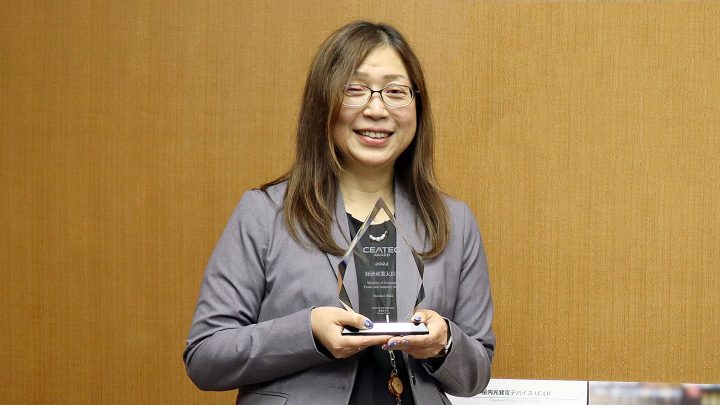
― Lastly, please tell us your future aspirations.
(Ichinose) Development has been completed, but we are currently making the final touches in preparation for mass production to begin in fiscal 2023. We will do our best to create a device that satisfies everyone. In the future, I hope to apply this knowledge to next-generation solar cells, such as perovskite solar cells, and develop them as low-cost power generation devices.
(Tsuda) Products equipped with LC-LH can become a familiar part of everyday life without the stress of replacing batteries. For example, it could be useful in an aging society, such as a sensor to monitor the elderly. We will work with Sharp’s product business division to consider various possibilities. Of course, SDTC produces displays, so we would also like to create products that incorporate displays.
― Thank you very much.
Previously, when I published a blog about beacons that utilize dye-sensitized solar cells, I realized the great potential of dye-sensitized solar cells that can generate electricity even in a dark circumstance. LC-LH has evolved significantly through the fusion of liquid crystal craftsmanship and solar cell technology accumulated over many years, and I’m looking forward to seeing it become even bigger in the future. Please look forward to future developments.
(Public Relations H)
<Related sites>
■Press Release:Sharp Indoor Photovoltaic Device, LC-LH Wins the Minister of Economy, Trade and Industry Award in CEATEC AWARD 2022
